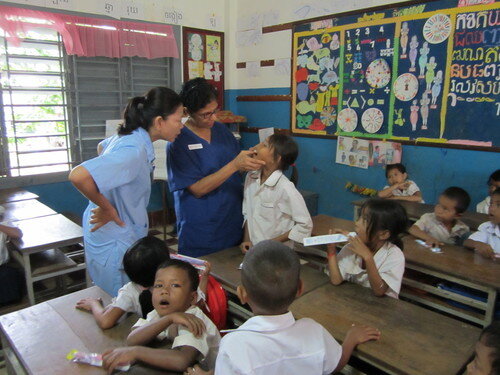
Angkor Hospital for Children
The Challenge
Poor oral hygiene in Cambodia has resulted in extensive issues related to dental care. Dental decay is rampant in children because of insufficient fluoride in the drinking water and lack of understanding on the part of the parents on how to care for the rapidly developing dentition in children. By the time the children are teenagers, the dental decay has basically destroyed the enamel, and the children are in pain. Access to a dentist is limited or not available due to cost and limited number of dentists. The only relief from dental pain was extraction of even the permanent teeth.
The Innovation
Angkor Hospital for Children (AHC) with funding from Friends Without a Border (FWAB) has been established in the town of Siem Reap, Cambodia, to deliver free healthcare. The Sumar-Lakhani Foundation in partnership with Friends Without a Border have established a pediatric dental department at AHC. Proper equipment was set up to deliver dental care with fillings and pulp therapy as a means of saving permanent teeth. Dr Dilshad Sumar has provided guidance and training to the staff and she also coordinates international volunteers to spend some time utilizing their expertise with AHC dental department. SLF in association with the AHC dental staff have established an outreach program reaching several thousand elementary school students to administer fluoride rinses on a weekly basis and to provide instructions on dental hygiene.
Long Term Impact
As a result of this effort, most children get to save their teeth into adulthood. The school children receive regular visit from the AHC dental staff to reinforce the importance of early and regular dental care. Weekly application of fluoride rinses have shown a substantial reduction in dental decay. The long-term goal is to have all Cambodian children smile with pride and confidence.
The delivery of pediatric health and dentalcare has been so successful in Siem Reap, Cambodia that Friends Without a Border has initiated a similar project in Luang Prabang, in the neighboring country of Laos. A children’s wing of the Provincial hospital is scheduled to be opened in 2015. To start off with the initial Base line Medical/Dental survey of the people in the villages of Luang Prabang, SLF was instrumental in creating basic module of survey. SLF also supplied toothbrushes as part of the survey initiative, and will continue to participate in the dentalcare initiatives of the Luang Prabang community.
“The average five-year-old in Phnom Penh has ten decayed teeth, and a recent study of 16-18 year old adolescents showed that they had an average of six decayed permanent teeth. By the age of 15, many children need to have permanent teeth extracted...Children with painful teeth often miss school, and have difficulty concentrating on their studies, and find it difficult to chew solid and more micronutrient food, therefore causing over-reliance on liquid and sweets for sustenance. ”
— Global Child Dental Fund














